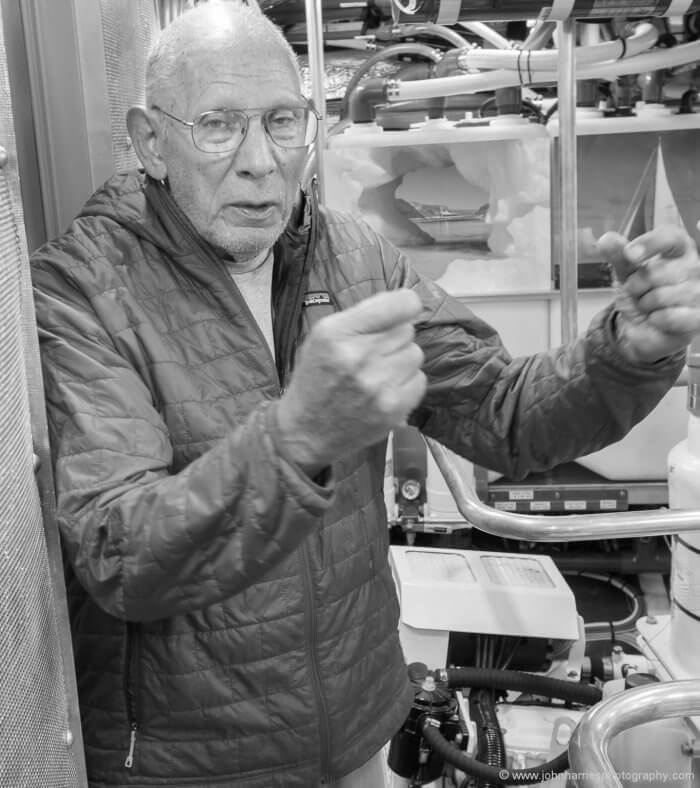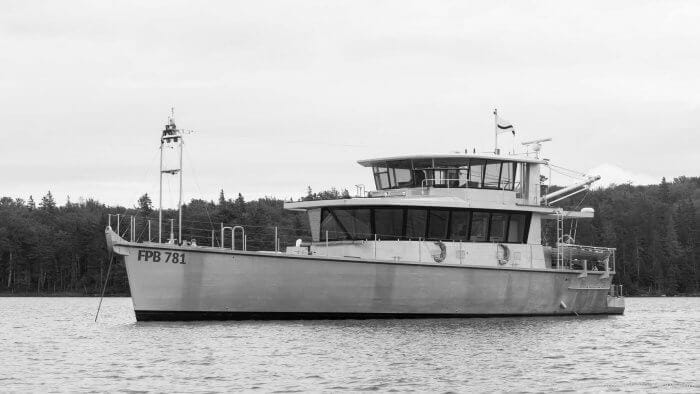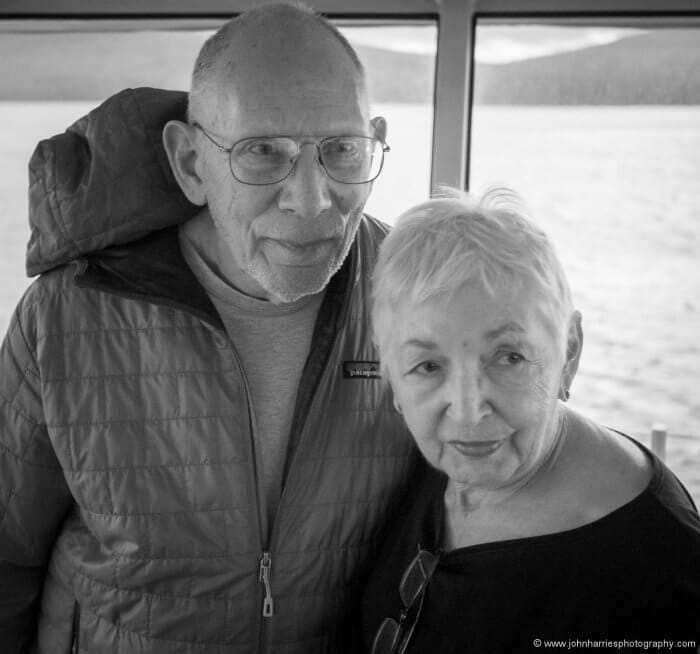
We shared an anchorage for a couple of days this summer with Steve and Linda Dashew on their new boat Cochise.
Phyllis and I first connected with Steve and Linda several years ago when they were planning a voyage to Greenland on their last boat, Wind Horse.
Since then we have met up several times when our wakes crossed and Steve and I talk via Skype from time to time, often about our shared passion for photography, but also about voyaging yacht design in general and offshore motorboats in particular.
Whenever we chat I always learn a huge amount, much of which AAC readers get to share through the posts I write. And I regard these meetings and conversations as a huge privilege.

I always joke that there is a faint smell of ozone in the air when I’m with Steve and he is thinking, and he is always thinking. Kind of like being in the same room with a supercomputer—Steve is a seriously smart guy.
I’m not going to get into any sort of detailed review of Steve and Linda’s new boat since that would take volumes, and anyway you can read all the details over at Setsail.
Rather, I want to share two really important things that we can all learn from these two fascinating people:
There Is No Perfect
For example, one of the things that I find most interesting about their new boat is that, although to the casual observer similar to Wind Horse, Cochise is actually very different. The former is optimized for higher speeds and the latter for fuel-efficient load carrying.


So Wind Horse and Cochise burn the same amount of fuel at cruise speed—about 10.5 knots if memory serves—even though Cochise is almost double the weight, making her almost twice as efficient on a tons-per-mile basis.
On the other hand, at higher speeds Wind Horse burns less fuel, making her more efficient on a pure miles-per-gallon basis, at least when getting there really quickly is the goal. And keep in mind that Wind Horse is already far more efficient than the average fat trawler at most any speed—talk about making a difference to motorboat design!
Tradeoffs
And that leads me to the next important lesson we can learn from Steve and Linda:
When I asked them if Cochise is a better boat than Wind Horse, the immediate answer was,
no, just different.
They then went on to share many of the changes in the later boat, but always with the caveat,
we changed this and got these benefits, but in turn this is the disadvantage of that change.
Retirement

By the way, Steve and Linda have just announced their retirement from designing and building boats so they can concentrate on cruising and enjoying Cochise. When the FPB boats currently in-build are finished, there will be no more new Dashew boats. Truly the end of an era.
And while I totally understand, and in fact applaud their decision, I’m also sad to think that their constant stream of fascinating and innovative boats that truly moved the needle of offshore boat design will come to an end—I have been watching and learning from Steve and Linda’s boats and writing since I first marvelled at an early Deerfoot at the Annapolis Boat Show some 35 years ago.
One more thing: Steve and Linda celebrated their fiftieth wedding anniversary earlier this year. Congratulations you two, long may you voyage together and inspire us all with your writing and photographs.

Steve and Linda are amazing! Their “Surviving the storm”, is a seminal work about an actual event that chronicles more than few cruisers caught in the Queen’s Birthday Storm of 1994, on the voyage from the tropics to New Zealand. Arguably the best ever heavy weather story as Steve interviews different crews with very different outcomes!
A riveting read and later a life saver when I encountered a “Crush Zone” with 10-12 meter seas in those very same waters on my way to Fiji!
Thank you Steve and Linda!
Michael Bowe,
Patanjali
Cochise has been at our dock for the past week, and we have enjoyed the Dashew’s company alone and with their friends from Tucson, Micheal and Nancy Morrell (who took 16 years to circumnavigate). I will soon do a full boat tour of Cochise and hopefully share as much about the design and boat as I can.
John, you are so right about the constant analysis and ever-developing design spiral. They are quite a couple.
I was just finishing construction of our boat, a heavy displacement Bill Atkin design, when I discovered Dashew’s Offshore Cruising Encyclopedia (1998 edition). Their design and equipment philosophies are pretty much diametrically opposed to everything that we did, but the book was and still is an astonishing resource that I have read (if not fully understood) cover to cover and have referred to on many occasions. I can’t say that I fully appreciate the aesthetic results of taking their thinking to the logical conclusions but I have occasionally fantasized about something like a Deerfoot or Sundeer. Those designs seem to have established the path for many of the production yachts of today, although without the same degree of rigour in planning or execution. There is no question that Steve and Linda Dashew have made leading contributions to the world of offshore sailing.
The Dashew’s are clearly very special people and have contributed so much to the offshore world both power and sail. Unlikely that I will ever be in the position to own a FPB or a Sundeer but that doesn’t mean I haven’t learnt a lot from them and their designs. Thank you for that. John and Phyllis the same applies to you, I’m learning lots but particularly liking your considered approach to cruising and it’s challenges, thank you too for AAC and to it’s other contributors, you’re all adding greatly to all our worlds.
Paul
Hi Paul,
Thanks for the kind words!
Any Comments from the Dashews on Dennis Harjama’s Artnautica LRC58 design. Seems to be a similar type of boat.
thx,mark
Hi Mark,
Let’s just say that I don’t think Steve is a fan. Also, the LRC 58, while similar in look to the Dashew boats, is in fact a very different type of boat with a radically different hull form from anything that Steve and Linda have ever done. You can read lots more about the LRC 58 and my thinking on the boat here: https://www.morganscloud.com/category/boat-design-selection/series-better-offshore-motor-boats/artnautica-58/
Hi John,
That link does not appear to work. Maybe it’s just my machine, but perhaps you could double check it. Thanks!
Whoops, wrong link on my clipboard, fixed now.
Also keep in mind that you can find that kind of thing using the search box at the top right of the site.
Steve and Linda are not just super smart, they are also super nice. When they found out our daughter, then 12, was interested in yacht design they had us over to Cochise for a tour and Steve spent lot of time looking at her drawings and talking design. I cannot post a picture in comments but here is the link: http://sv-fluenta.blogspot.com/2016/10/brushes-with-celebrity-dashew-edition.html.
Thanks for the good work with the website. We are currently “low-latitude” sailors but intending to head back to Canada via Alaska and the Marshall Islands over the next two years so we will have to start thinking “mid-to-high latitude” again.
Cheers,
Max
SV Fluenta
Presently New Caledonia
Hi Max,
Loverly photos, thanks for sharing them.
Hi John
what I know about motor boats and their design can probably be written on the head of a pin, but I have to say that when I saw ‘Wind Horse’ in the Hebrides a few years ago – it just looked right to me…
Good luck and safe cruising to the Dashews.
Colin
Hi Colin,
Actually, you know way more than you think you do about motorboat design in that the fundamentals of good design—the right prismatic coefficient, sensibly shaped symmetrical ends, etc—are the same. In fact I think that a background in fast efficient sailboats is part of Steven and Linda’s success. Gave them an advantage over the typical trawler designer who crams as much volume as possible in a given length and then throws horsepower at the resulting mess.
Thank you John for the FPB topic.
Like so many others, mr. Dashew has graciously answered all of my questions and comes across as a gentle giant and gentleman. It may well be the old slogan applies here: Behind every good man is a great lady.
Have immensely enjoyed his experiences, designs and ideas, but would have liked to see more teak in his interiors :).
FPB did remind me of Idlewild, but have no idea where it originated.
Our 60ft alu motorboat, with a sailboat like bilge, has about 5-7tons of lead ingots and have always wondered if this applies to FPB boats. With 2x155hp old style diesels, at 8knots it uses about 2 USgln/hr.
We wish the Dashew family a well deserved retirement, but do hope to enjoy their writings for many years to come.
Rene
Hi Rene,
Wind Horse is ballasted, but, as I understand it, the newer FPBs are not but rather achieve impressive stability by meticulous attention to keeping all weight low and making sure that anything up high is built light.
John and Rene,
The newer FPB’s are ballasted. Our current boat, Buffalo Nickel, is FPB 64-7 and they have 6 tons of lead as ballast. That said, the design does keep the weight low and Steve hates anything heavy high up in the boat. Comfort underway is almost impossible to describe on a FPB-there is no comparison to a traditional displacement trawler.
BTW, Getting to know Steve and Linda is one of the biggest advantages of FPB ownership.
Stan and Val Creighton
MV FPB Buffalo Nickel
Currently in New Zealand
Hi Stan,
Thanks for the correction on that from someone who clearly knows!
Interesting because “Cochise” is not ballasted.
Thank you Stan and John for your comments, much appreciated.
Alu has many advantages, being light and strong and wondered how FPBs got away with it .
FPB boats do use a heavier or thicker hull plates, which is a more efficient way than stacking lead ingots in the bilge.
Going back to my merchant navy days, we could always spot an iron ore carrier miles away, as they, even in calm seas , were rolling more than ships with a lighter cargo.
Have noticed round bilge boats appear to roll much less than others at anchor.
Just had mine hauled out for a bottom paint, was advised to go with the “harder” Mission Bay product, as I couldn’t find out what was put on before we had the boat.
Since the boat is a one of a kind I didn’t really know its weight, but was pleased to learn it to be around 90,000lbs, as it is build more like a small ship.
Congratulations Stan with your FPB, happy trails!
Rene